The article “Ardwīsūr Anāhīd” was written by Mary Boyce in the Encyclopedia Iranica. Kindly note that the images and accompanying captions do not appear in the original Encyclopedia Iranica article. For more on the mythology and cultures of ancient Iran see:
=======================================================================
Ardwīsūr Anāhīd, Middle Persian name of Arədvī Sūrā Anāhitā, a popular Zoroastrian yazatā; she is celebrated in Yašt 5 (known as the Ābān Yašt) which is one of the longest and best preserved of the Avestan hymns. Sūrā and anāhitā are common adjectives, meaning respectively “strong, mighty” and “undefiled, immaculate.” Only arədvī (a word otherwise unknown) is special to this divinity, and on etymological grounds it too has been interpreted as a feminine adjective, meaning “moist, humid.” The proper name of the divinity in Indo-Iranian times, H. Lommel has argued, was Sarasvatī, “she who possesses waters” (“Anahita-Sarasvati,” Asiatica, Festschrift F. Weller, Leipzig, 1954, pp. 405-13). She was still worshiped in Vedic India by this name, which was also given there to a small but very holy river in Madhyadeśa. In its Iranian form (*Harahvatī), her name was given to the region, rich in rivers, whose modern capital is Kandahar (Av. Haraxᵛaitī-, OPers. Hara(h)uvati-, Greek Arachosia); originally *Harahvatī seems to have been the personification of a great mythical river which plunges down from Mt. Harā into the sea Vourukaša and is the source of all the waters of the world. It is thus that the yazatā is celebrated in Yašt 5 and in the Pahlavi books; but in time, it appears, her proper name fell into disuse in favor of her epithets arədvī and sūrā, which eventually coalesced to give her the Middle Iranian name of Ardwīsūr. In her hymn the river-goddess is described as a beautiful, strong maiden, clad in beaver-skins (5.129), who drives a chariot drawn by four horses: wind, rain, clouds, and sleet (5.120). As water-divinity she is worshiped as a bestower of fertility, who purifies the seed of all males, the wombs of all females, and makes the milk flow which nourishes their young (5.2). Like the Indian Sarasvatī, she nurtures crops and herds; and she is hailed both as a divinity and as the mythical river which she personifies, “as great in bigness as all these waters which flow forth upon the earth” (5.3). There is a mantic link in many ancient cultures between water and wisdom, and priests and their pupils pray to Arədvī Sūrā for knowledge (5.86); while in India Sarasvatī protects the study of the Vedas. As a water-divinity Arədvī Sūrā is linked with the Āpas (see Ābān), and verses from her hymn form the greater part of the Ābān Niyāyeš. She is also associated with Apąm Napāt (who, in the view of the present writer, represents the great ancient deity *Vouruna, see Apąm Napāt) and the rain-bringing Tištrya.
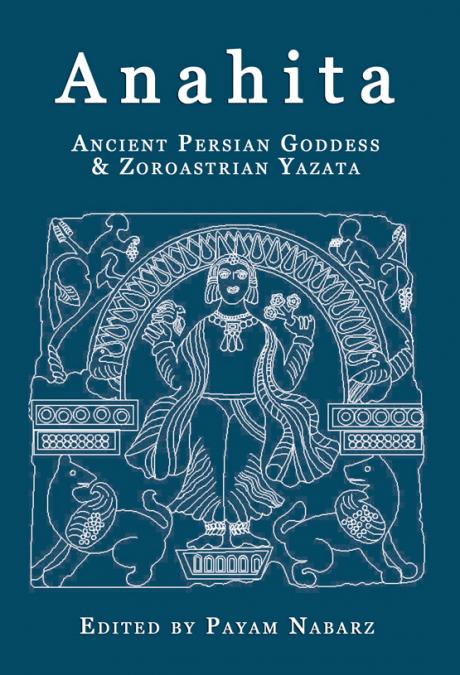
The Textbook Anahita-Ancient Persian Goddess & Zoroastrian Yazata (edited by Payam Nabarz) – for more click here…
It seems less in the character of a river-goddess that Arədvī Sūrā is also held to bestow upon her worshipers possessions such as chariots, arms, and household goods (5.130), as well as victory in battle and the destruction of foes (5.34ff.). Some of the verses which indicate these aspects of her power correspond closely with others addressed to Aši, yazatā of Fortune; and there seems to have been some blurring of identity between these two beautiful, chariot-driving goddesses. Linguistically Arədvī Sūrā’s hymn appears older than Aši’s Yt. 17), which is short and badly preserved; and so it has been assumed that, where there are verses in common, it was Aši who was the borrower. In a fluid, oral literature, however, such criteria cannot be relied on. Once Arədvī Sūrā gained greater popularity, her hymn would have been more often recited and so would be better preserved; there would be a tendency, moreover, for priests to seek to extend it in her honor. “Great-gifted Aši” is a Gathic figure, worshiped of old; and it seems probable that, as she suffered gradual eclipse by Arədvī Sūrā, verses once addressed to her were transferred to her rival, so that gifts properly sought from the goddess of Fortune came to be asked of the river-goddess.
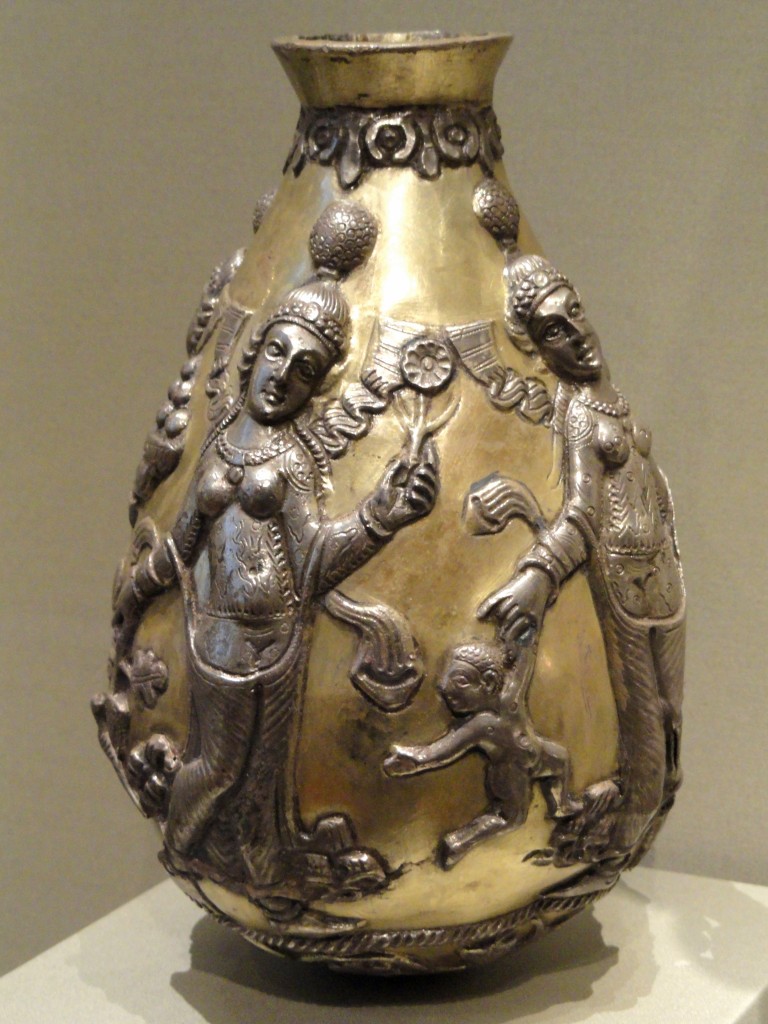
Silver-Gilt Sassanian vessel housed at the Cleveland Museum of Art. depicting the Goddess Anahita dated to the 4th-6th centuries CE (Picture Source: Public Domain).
Arədvī Sūrā’s striking growth in popularity seems to have begun in Achaemenid times, through her identification with the Western Iranian divinity *Anāhiti, known from Greek sources as Anaitis (see below). The Achaemenids’ devotion to this goddess evidently survived their conversion to Zoroastrianism, and they appear to have used royal influence to have her adopted into the Zoroastrian pantheon. The problem of how to offer veneration to a divinity unknown to the Avesta was solved by assimilating *Anāhiti to *Harahvaitī Arədvī Sūrā Anāhitā, whose third epithet was very close to the western divinity’s proper name, and indeed may already in late Old Persian have become identical with it, through the dropping of the final vowel in ordinary speech.
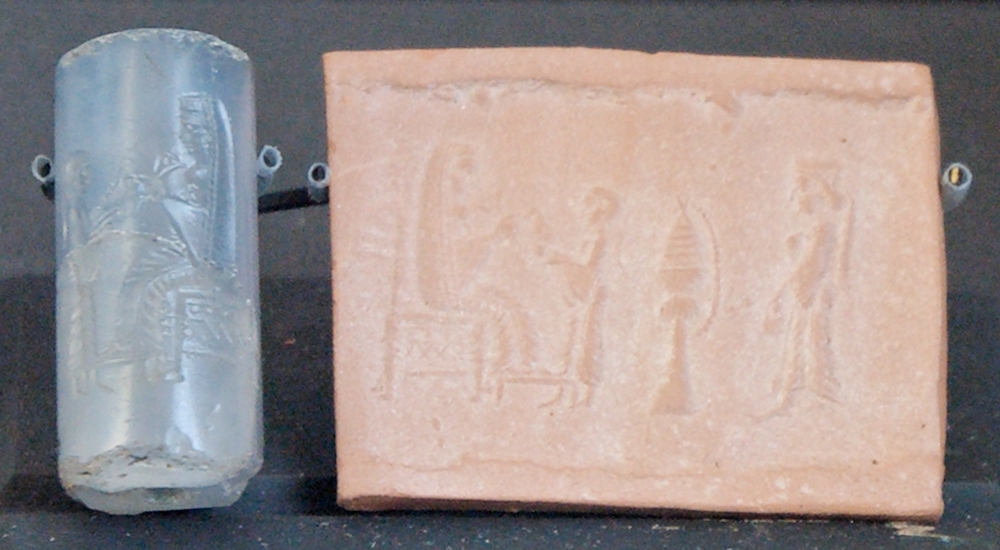
AnAchaemenid chalcedony cylinder seal housed at the Louvre (Source: Public Domain). possibly featuring a regal figure (queen or princess?) or a female deity (Anahita?).
The first Achaemenid king known publicly to have acknowledged “Anāhit(a)”—that is, the composite being born of the assimilation of Arədvī Sūrā Anāhitā and *Anāhiti—was Artaxerxes II (404-359 B.C.), who in inscriptions invoked her after Ahura Mazdā and Mithra, and who also set up cult-statues in her honor (see further under Anaitis); and it was presumably after this that verses were composed and incorporated in Yašt 5 which apparently describe a temple statue (see Ābān Yašt). In these Arədvī Sūrā Anāhitā is invoked, not as the personification of a rushing river, but as a magnificently static being, richly arrayed in high-girt robe and jewel-encrusted mantle, with golden shoes and earrings, necklace, and crown. There is no similar description of any other Avestan divinity; and the contrast between it and the concept of Arədvī Sūrā in bold motion, drawn swiftly on by her four elemental steeds, suggests how uneasy in some ways was the reconciliation of *Harahvatī and *Anaitis. In the Pahlavi books (some of which represent lost Avestan texts), the two are still sometimes treated as separate divinities, with Ardwīsūr as the personification of the mythical river, and Anāhīd, the fertility goddess, identified with the planet Venus. Thus the Greater Bundahišn, in describing the world’s lakes and seas, says they all have their origin with “Ardwīsūr” (10.2, 5); whereas, in a paragraph concerned with the stars and planets (5.4), there is mention of “Anāhīd ī Abāxtarī,” i.e., the planet Venus. In other chapters, however, the two divine beings are identified, e.g., 3.17, “Ardwīsūr who is Anāhīd, the father and mother of the Waters” (Ardwīsūr ī Anāhīd, pid ud mād ī Ābān). In the cult the two became indissolubly one. This is attested by her names in the Avesta; further, at a shrine in Asia Minor in Roman times “Anaïtis” was invoked with what seems to be an ancient epithet of *Harahvatī’s, namely, “of high Harā (barzochára; see R. Schmitt, “Ein neues Anahita-Epitheton aus Kappadokien,” ZVS 84, 1970, pp. 207-10; see, contra, S. Wikander, in Acta Orientalia 34, 1972, pp. 13-15), while in another Greek inscription there she is spoken of as “Anaïtis of the sacred water” (L. Robert, “Monnaies grecques de l’époque impériale,” Revue numismatique, 6th series, 18, 1976, pp. 45-46).
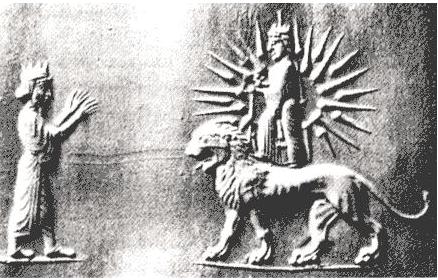
King Artaxerxes II (at left) facing the goddess Anahita who sits atop a lion (Picture Source: OwnerlessMind). In the background to Anahita can be seen the clear display of the sun which is a representation of the ancient Iranic god Mithras. Note that the sun emanates 21 rays, the same symbol which is used by varous ancient Iranic cults among the Kurds of Iran, Iraq and Turkey. The 21 rays may be related to the festival date of Mehregan (Festival of the Sun-god Mithra) which takes place from the 16th to the 21st of Mehr of the Iranian calendar.
Nevertheless, there is some evidence to suggest that there were orthodox priests who put up what resistance they could to the royally favored syncretic cult, with its alien elements of temple- and image-worship. Thus, although Yašt 5 seems to have been adapted to incorporate the veneration of Anaïtis, and although “Anāhitā” seems to have displaced *Vouruna in the triad of high divinities worshipped by the Achaemenids, yet in the liturgy of the yasna (y.2.5 et passim) it is still *Vouruna, as Apąm Napāt, who is invoked with the Waters. Moreover, in the dedications of the days of the month (bestowed, it seems, in late Achaemenid times) a day is assigned to Aši (Middle Persian Ard), but none to her rival Arədvī Sūrā Anāhitā. It also seems probable that the characteristic Zoroastrian temple-cult of fire developed at this same period in opposition to the image-cult of Anaïtis (see further under ātaš). Despite this degree of priestly resistance, the cult of Arədvī Sūrā Anāhitā, uniting as it did those of water-goddess and mother-goddess, and being royally promoted, became widely popular. Worship was, in general, offered to the divinity under the name of Anāhīd (Anāhīt)/Anaïtis, which suggests the strength of Achaemenid influence. The Arsacids followed the example set by their predecessors in venerating Aramazd-Mihr-Anāhīd as their chief helpers; and the woman’s name Āb-Nāhīd (“Anāhīd of water”) is first attested in the Parthian period (see Faḵr-al-dīn Asʿad Gorgānī, Vīs o Rāmīn, ed. M. Mīnovī, Tehran, 1314 Š./1935, section 9.5). The temples to Anāhīt founded by Artaxerxes II probably all survived Alexander’s conquest and Seleucid domination, even though pillaged. Thus the one at Hamadān (Ecbatana) was twice plundered and was stripped of its gold and silver roof-tiles; but it was evidently restored, for Isidore of Charax (Parthian Stations 6) wrote of sacrifices being continually offered there in his day. A temple at Kangāvar was apparently also devoted to Anāhīd, if this place is indeed Isidore’s Concobar (loc. cit.); for he said that a temple there was dedicated to Artemis, which was one of the Greek identifications of Anāhīd (but see below, sec. iv). Hellenic influence having given a new impetus to the cult of images in Iran, it may safely be assumed that Anāhīd’s statues were still venerated during the Parthian period; and positive evidence for this comes from Armenia, then a Zoroastrian land. Here Anāhīd was much beloved, being invoked as “noble Lady… mother of all knowledge, daughter of the great and mighty Aramazd.” There are references to offerings at her altars; and in 36 B.C. one of Mark Antony’s soldiers carried off a famous statue to her in solid gold from the temple at Erez. A fine bronze head, like that of a Greek Aphrodite, has been found at Satala, which is thought to belong to a statue of Anāhīd. (All statues in Armenia, according to an old source, were made by Greek craftsmen.)
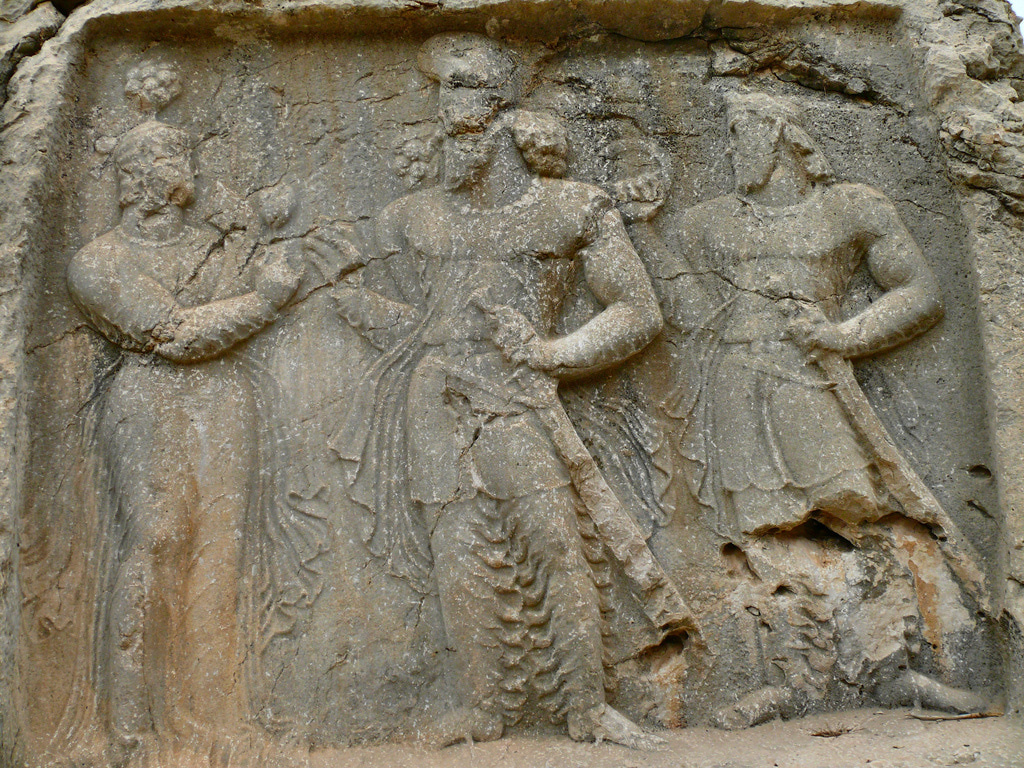
An image of Ardashir I or Bahram II (middle) and prince Shapur I or Bahram III “Sakan Shah [King of the Sakas]” (at right) and what appears to be Goddess Anahita (or a Sassanian Queen) (Picture Source: Atefeh Ashrafian, 2009).
It is very likely that in the Parthian period, and probably even earlier, Ardwīsūr Anāhīd was also worshipped at many natural sanctuaries throughout the land, created by lake or mountain spring. One of these (which, to judge by its great sanctity, is probably old) was on a mountain with a spring at its foot, near the city of Ray. This shrine seems to have been devoted to Anāhīd as “the Lady of the Land” (Šahrbānū); and so great was the veneration in which it was held that, after the Arab conquest, it was rededicated to “Bībī Šahrbānū,” held to be a daughter of the last Sasanian king and the widow of Ḥosayn, son of ʿAlī b. Abī Ṭāleb (see M. Boyce, “Bibi Shahrbānū and the Lady of Pārs,” BSOAS 30, 1967, pp. 30-44). Muslim prayers and sacrifices are accordingly offered there to this day. Worship of the divine beings in the presence of natural objects is more consonant with orthodox Zoroastrianism than is the veneration of man-made images; and it is probable that an iconoclastic spirit sprang into being among some groups of Zoroastrians at the moment when Artaxerxes II set up the first statues to Anāhīd. There are slight indications that this spirit began to find active expression towards the end of the Parthian period, as Hellenistic influences waned; and it is possible that some destruction of statues, Anāhīd’s among them, began then. At the beginning of the 3rd century A.D. the Persian Sasanians were, it seems, hereditary guardians of a temple dedicated to Anāhīd at Eṣṭaḵr (probably one of the foundations of Artaxerxes II), which Ṭabarī describes as “the temple of the fire of Anāhīd”; the fact that Šāpūr I’s queen of queens (his daughter-wife) was called Ādur-Anāhīd (“Anāhīd of the fire”) suggests that a sacred fire, consecrated to Anāhīd, had replaced her image in this temple before the princess was born—-i.e., by the beginning of Sasanian ascendancy. Two reigns later, under Bahrām II, the high priest Kirdēr was honored with responsibility for two sacred fires at Eṣṭaḵr, one called “the Fire of Anāhīd the Lady,” the other “the Fire of Anāhīd-Ardašīr” (line eight of his Kaʿba-ye Zardošt inscription). The significance of the second dedication is uncertain.
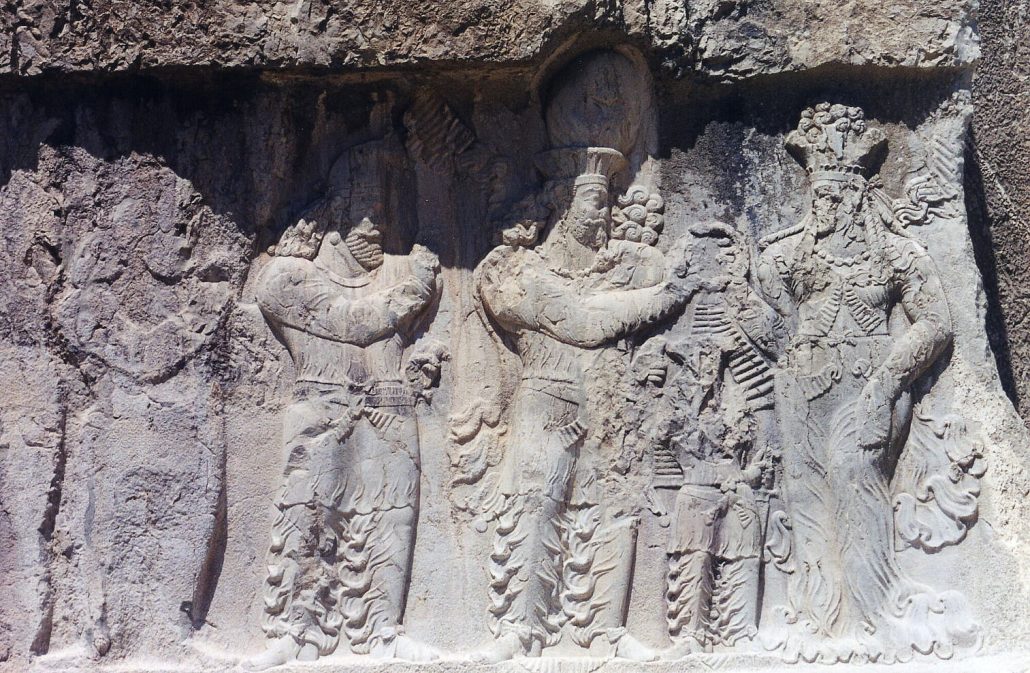
Sassanian King Narseh (r. 293-302 CE) (second figure from the right) at Nagshe Rustam receives from Goddess Anahita the “Farr” (divine glory) symbolized as a ring (Source: Ginolerhino 2002 in Public Domain).
Anāhīd was thus the patron divinity (under Ohrmazd) of the Sasanians, and her cult flourished during their rule as it had done during the two earlier empires, although she was now officially venerated, it seems, without statues. It has been suggested that a sunken temple made by Šāpūr I beside his palace at Bīšāpūr, whose stone-paved sanctuary could be flooded with water, was a temple to Anāhīd, where she could be worshiped in the presence of her natural icon, water (R. Ghirshman, Bīchāpour I, Paris, 1971; idem, Iran, Parthes et Sassanides, Paris, 1962, p. 149). Sasanian iconoclasm was evidently directed only, however, at free-standing cult-images, and representations of Anāhīd survive in Sasanian art. In an investiture scene carved at Naqš-e Rostam, Narseh had himself represented receiving the diadem of kingship from the hand of a female divinity generally recognized as Anāhīd; late in the epoch Ḵosrow Parvēz showed his fidelity to the family tradition by having Anāhīd present to support him at his investiture scene also, which was carved in the lake-side grotto of Ṭāq-e Bostān (for other interpretations see G. Hermann, The Iranian Revival, Oxford, 1977, p. 103). Here the divinity holds in one hand a tilted jug, from which water flows. There is little doubt that under the Sasanians Anāhīd overshadowed all other female divinities as far as private prayers and devotion were concerned, although in public worship the great Amešaspands, Spendārmad, Hordād and Amurdād, continued to be more honored, thanks evidently to the conservatism and orthodoxy of the priests. Even granted the widespread popularity of Anāhīd, however, it is doubtful whether the current tendency is justified whereby almost every isolated female figure in Sasanian art, whether sitting, standing or dancing, clothed or semi-naked, is hailed as her representation (see below).
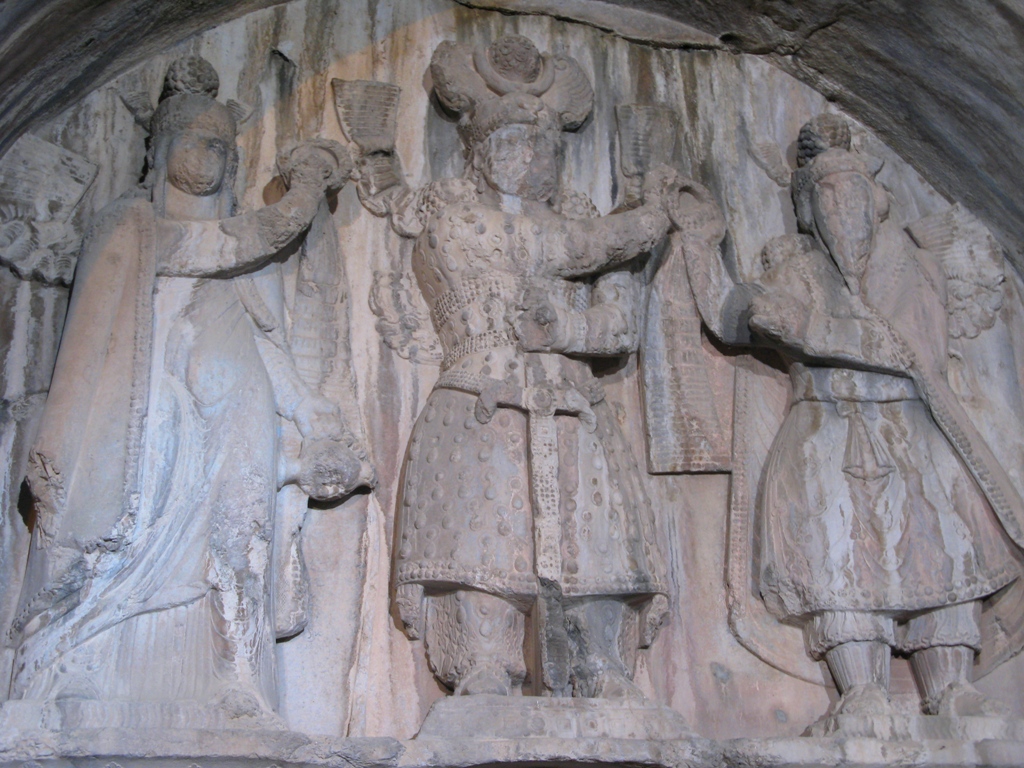
Investiture scene above the late Sassanian armored knight at the vault at Tagh-e Bostan. To the left stands Goddess Anahitawith her right hand raised, holding a diadem of glory or “Farr” towards Khosrow II at center who receives a diadem with his right hand from Ahura-Mazda or the chief Magus. Anahita was a revered goddess of war among Sassanian warriors (Source: Shahyar Mahabadi, 2004).
The dedication of her fire at Eṣṭaḵr shows that, to Persians as to Parthians, Anāhīd was known as “the Lady.” In his inscription at Paikuli (Pahlavi text, line 10), Narseh invokes “Ohrmazd and all the yazads, and Anāhīd who is called the Lady”; and a Sasanian gem bearing what is thought to be a representation of her has beneath it simply the identification “the Lady” (bʾnwky). This usage influenced Zoroastrian priestly terminology in late Sasanian and Islamic times, and the yazata is spoken of then in religious works as “Ardwīsūr the Lady” and “Ardwīsūr, the Lady of the Waters” (for references see M. Boyce, “Bibi Shahrbānū,” p. 37, nn. 27, 28). One of the most beloved mountain shrines of the Zoroastrians of Yazd, set beside a living spring and a great confluence of water-courses, is devoted to Bānū-Pārs, “The Lady of Persia.”
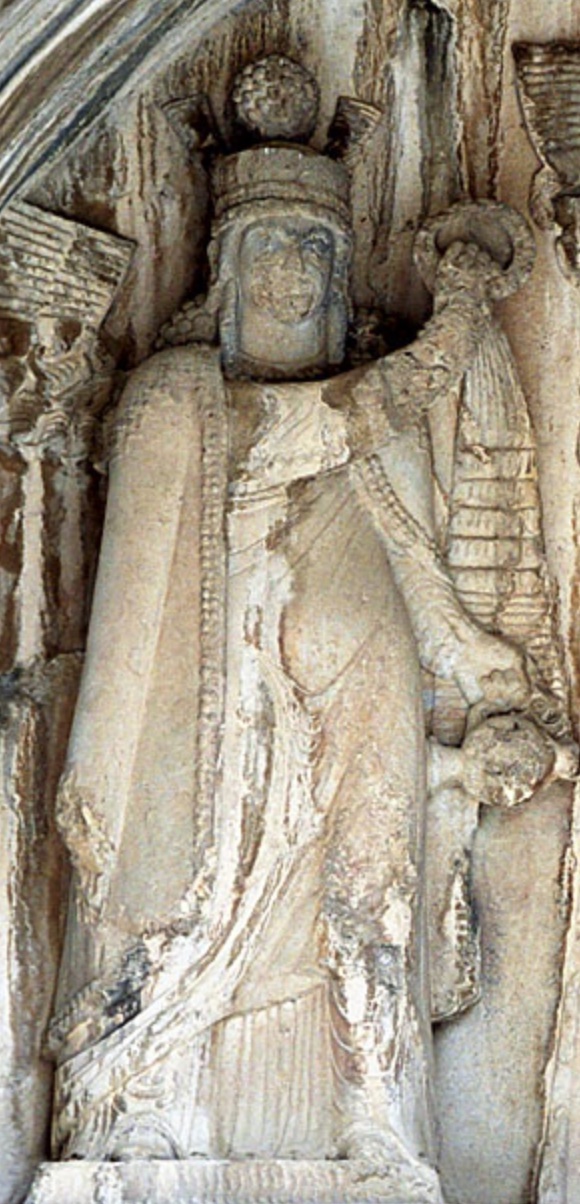
A close-up of Anahita at Nagshe Rustam (Image Source: adapted from Philippe Chavin in Public Domain).
This sanctuary appears to have been devoted originally to Anāhīd “the Lady”; being rededicated in Islamic times, like the shrine of Bībī Šahrbānū near Ray, to a legendary Sasanian princess (see M. Boyce, “Bibi Shahrbānū”). This and other new dedications appear to have led to the partial eclipse of Anāhīd herself in living Zoroastrianism, although the veneration of the waters continues as an important part of the cult. It may be suggested that most of the many places in Iran, in mountains and by springs, which are named for “the Maiden” (Doḵtar) or “the Lady” (Bībī) were once sacred to Anāhīd. The Yazdi Zoroastrians still today often call their daughters by the name Āb-Nāhīd.
Bibliography
See also M. H. Ananikian, Armenian Mythology, Boston, 1925, pp. 20-21.
L. H. Gray, Foundations, pp. 55-62.
H. Lommel, Die Yäšt’s des Awesta, Göttingen and Leipzig, 1927, pp. 26-32.
S. Wikander, Feuerpriester in Kleinasien und Iran, Lund, 1946, chap. III, VII.
J. Šahīdī, Čerāḡ-e rowšan dar donyā-ye tārīk, Tehran, 1333 Š./1954.
M. E. Bāstānī Pārīzī, Ḵātūn-e haft qaḷʿa, Tehran, 1344 Š./1965.
M. Boyce, “Iconoclasm among the Zoroastrians,” Studies for Morton Smith at sixty, ed.
J. Neusner, Leiden, 1975, pp. 93-111.
Idem, Zoroastrianism I, pp. 71-74.



